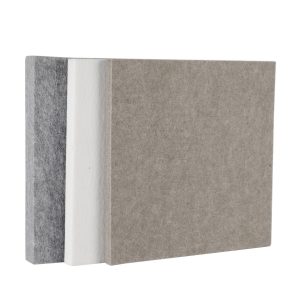Sound absorption panels are an essential component of any space that requires acoustic isolation and soundproofing. They are widely used in commercial spaces, recording studios, and home theaters, to name a few. However, choosing the right sound absorption panels can be a daunting task, especially for those who are not well-versed in soundproofing. With so many options available in the market, it can be overwhelming to select the right one that meets your specific needs. In this blog post, we will explore some of the key factors to consider when choosing sound absorption panels.

Acoustic performance and absorption rates.
When selecting sound absorbing panels, one of the most critical factors to consider is their acoustic performance and absorption rates. The goal of sound absorbing panels is to reduce the noise levels in a room by absorbing sound waves. The effectiveness of sound absorbing panels in doing this depends on their absorption rate.
Panels made of porous materials such as fiberglass, mineral wool, or acoustic foam are highly effective at reducing noise levels. It is essential to understand the acoustic performance and absorption rates of sound absorbing panels to make an informed decision when selecting the best panels for a particular application.
Material and thickness considerations.
The thickness of the panel can also impact its sound absorption effectiveness. Thicker panels generally absorb more sound energy than thinner ones. However, it is important to note that thicker panels can also be heavier and more difficult to install, especially in ceiling applications. Therefore, it is important to consider both the material and thickness of the sound absorbing panels to ensure optimal sound absorption performance.
Installation and maintenance requirements.
When choosing sound absorbing panels, installation and maintenance requirements are important factors to consider. The installation process can vary depending on the type of panel and the location in which it will be installed. Some panels may require professional installation, while others can be easily installed with basic tools and hardware. It is important to ensure that the panels are properly installed to achieve maximum sound absorption.
Aesthetics and design options.
When considering sound absorbing panels, it is important to take into account the aesthetics and design options. Sound absorbing panels come in a variety of styles and colors to fit any interior space. From traditional fabric-wrapped panels to modern geometric designs, there is a panel to fit any aesthetic preference.
It is important to consider not only the acoustical performance of the panel, but also how it will fit into the overall design scheme of the space. Choosing panels that blend seamlessly with the existing decor can enhance the visual appeal of the room while also providing effective sound absorption.
Budget and cost-effectiveness analysis.
Budget and cost-effectiveness analysis are important factors to consider when choosing sound absorbing panels. It is important to evaluate the different options available in the market and compare their prices to determine which option is the most cost-effective.
Keep in mind that cheaper options may not necessarily be the best in terms of quality and sound absorption performance. Therefore, it is crucial to strike a balance between cost and quality to ensure that you get value for your money.
In conclusion, selecting the right sound absorbing panels for your space requires a careful consideration of various factors. These include the type of space, the level of noise, the desired aesthetic, and the budget. It’s important to work with a reputable supplier or acoustics consultant who can provide expert advice on the appropriate panels for your specific needs. By taking the time to make an informed choice, you can create a more comfortable and productive environment for yourself and those around you.

One Response